University Classroom Digital Device Usage: Impact and Recommendations
VerifiedAdded on 2022/08/25
|27
|8754
|34
Report
AI Summary
This report investigates the multifaceted impact of digital devices within university classrooms, analyzing both their advantages and disadvantages. It begins with an introduction outlining the author's personal interest in the topic, stemming from observations of distraction and potential negative impacts on learning. The report then provides a comprehensive literature review, examining the effects on educational outcomes, specifically focusing on distraction as a significant factor, and exploring the role of classroom policies and practices in managing this. The review extends to the impacts on mental and physical health, including stress, anxiety, and potential neurological and vision effects. An application section discusses students' preferences for digitized versus non-digitized learning environments, culminating in a thesis statement. The report then discusses the implications on short and long-term memory, open-book assessments, and proposes recommendations such as non-mandatory device use, mental and physical health interventions, and the use of network monitoring to amend classroom policies. The report concludes with a summary of the findings and discusses broader implications, highlighting the need for a balanced approach to technology integration in higher education.
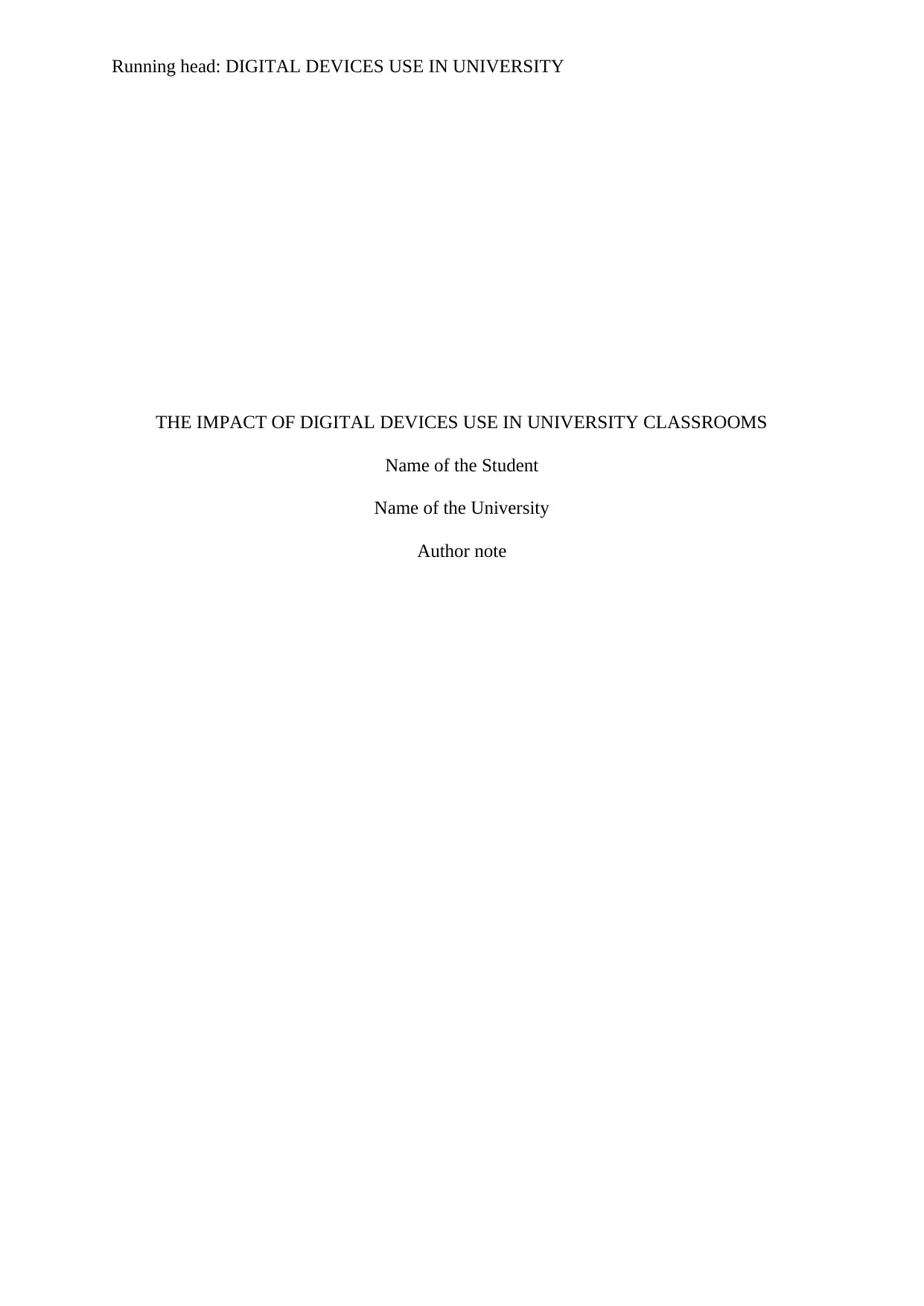
Running head: DIGITAL DEVICES USE IN UNIVERSITY
THE IMPACT OF DIGITAL DEVICES USE IN UNIVERSITY CLASSROOMS
Name of the Student
Name of the University
Author note
THE IMPACT OF DIGITAL DEVICES USE IN UNIVERSITY CLASSROOMS
Name of the Student
Name of the University
Author note
Paraphrase This Document
Need a fresh take? Get an instant paraphrase of this document with our AI Paraphraser
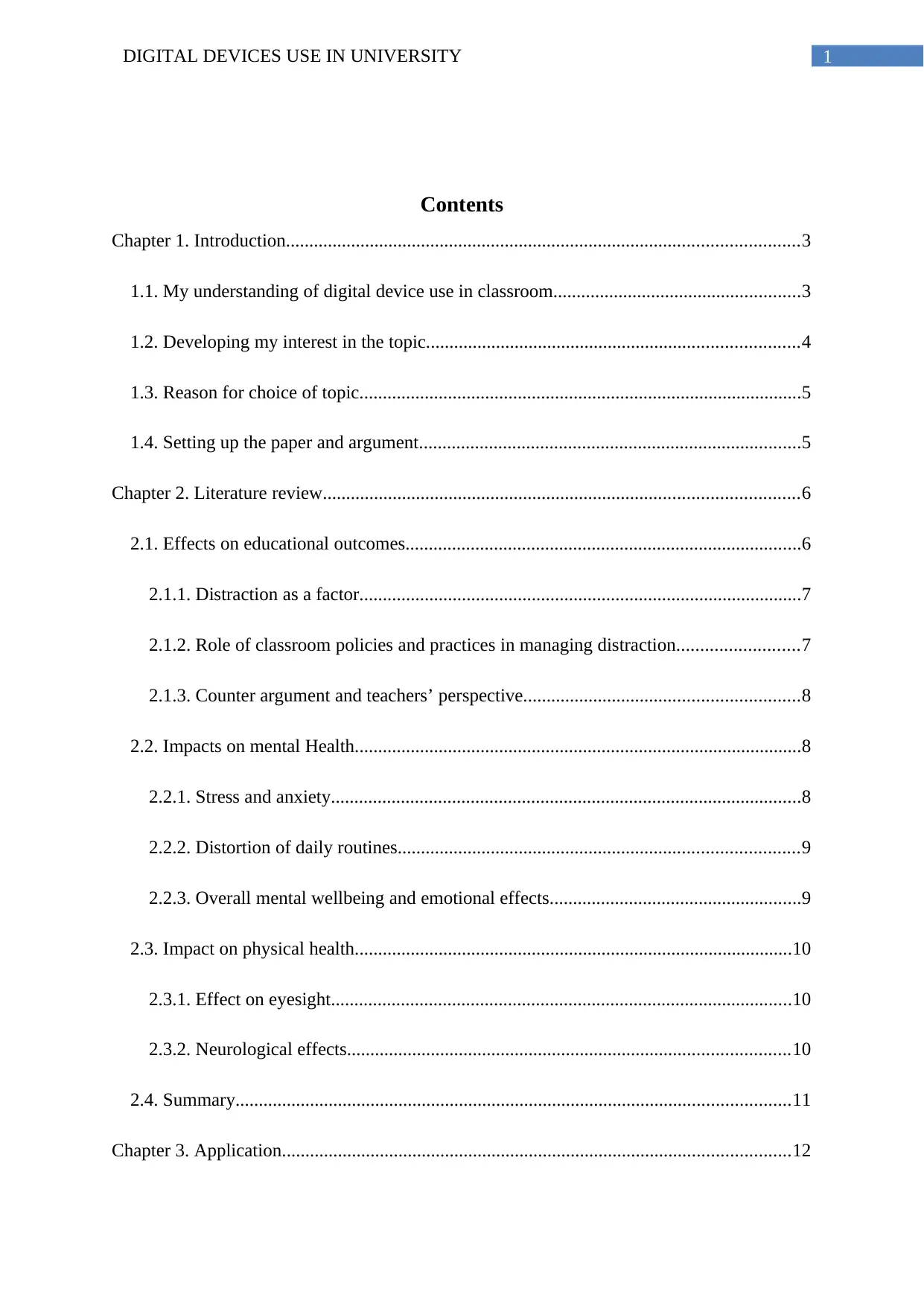
1DIGITAL DEVICES USE IN UNIVERSITY
Contents
Chapter 1. Introduction..............................................................................................................3
1.1. My understanding of digital device use in classroom.....................................................3
1.2. Developing my interest in the topic................................................................................4
1.3. Reason for choice of topic...............................................................................................5
1.4. Setting up the paper and argument..................................................................................5
Chapter 2. Literature review......................................................................................................6
2.1. Effects on educational outcomes.....................................................................................6
2.1.1. Distraction as a factor...............................................................................................7
2.1.2. Role of classroom policies and practices in managing distraction..........................7
2.1.3. Counter argument and teachers’ perspective...........................................................8
2.2. Impacts on mental Health................................................................................................8
2.2.1. Stress and anxiety.....................................................................................................8
2.2.2. Distortion of daily routines......................................................................................9
2.2.3. Overall mental wellbeing and emotional effects......................................................9
2.3. Impact on physical health..............................................................................................10
2.3.1. Effect on eyesight...................................................................................................10
2.3.2. Neurological effects...............................................................................................10
2.4. Summary.......................................................................................................................11
Chapter 3. Application.............................................................................................................12
Contents
Chapter 1. Introduction..............................................................................................................3
1.1. My understanding of digital device use in classroom.....................................................3
1.2. Developing my interest in the topic................................................................................4
1.3. Reason for choice of topic...............................................................................................5
1.4. Setting up the paper and argument..................................................................................5
Chapter 2. Literature review......................................................................................................6
2.1. Effects on educational outcomes.....................................................................................6
2.1.1. Distraction as a factor...............................................................................................7
2.1.2. Role of classroom policies and practices in managing distraction..........................7
2.1.3. Counter argument and teachers’ perspective...........................................................8
2.2. Impacts on mental Health................................................................................................8
2.2.1. Stress and anxiety.....................................................................................................8
2.2.2. Distortion of daily routines......................................................................................9
2.2.3. Overall mental wellbeing and emotional effects......................................................9
2.3. Impact on physical health..............................................................................................10
2.3.1. Effect on eyesight...................................................................................................10
2.3.2. Neurological effects...............................................................................................10
2.4. Summary.......................................................................................................................11
Chapter 3. Application.............................................................................................................12
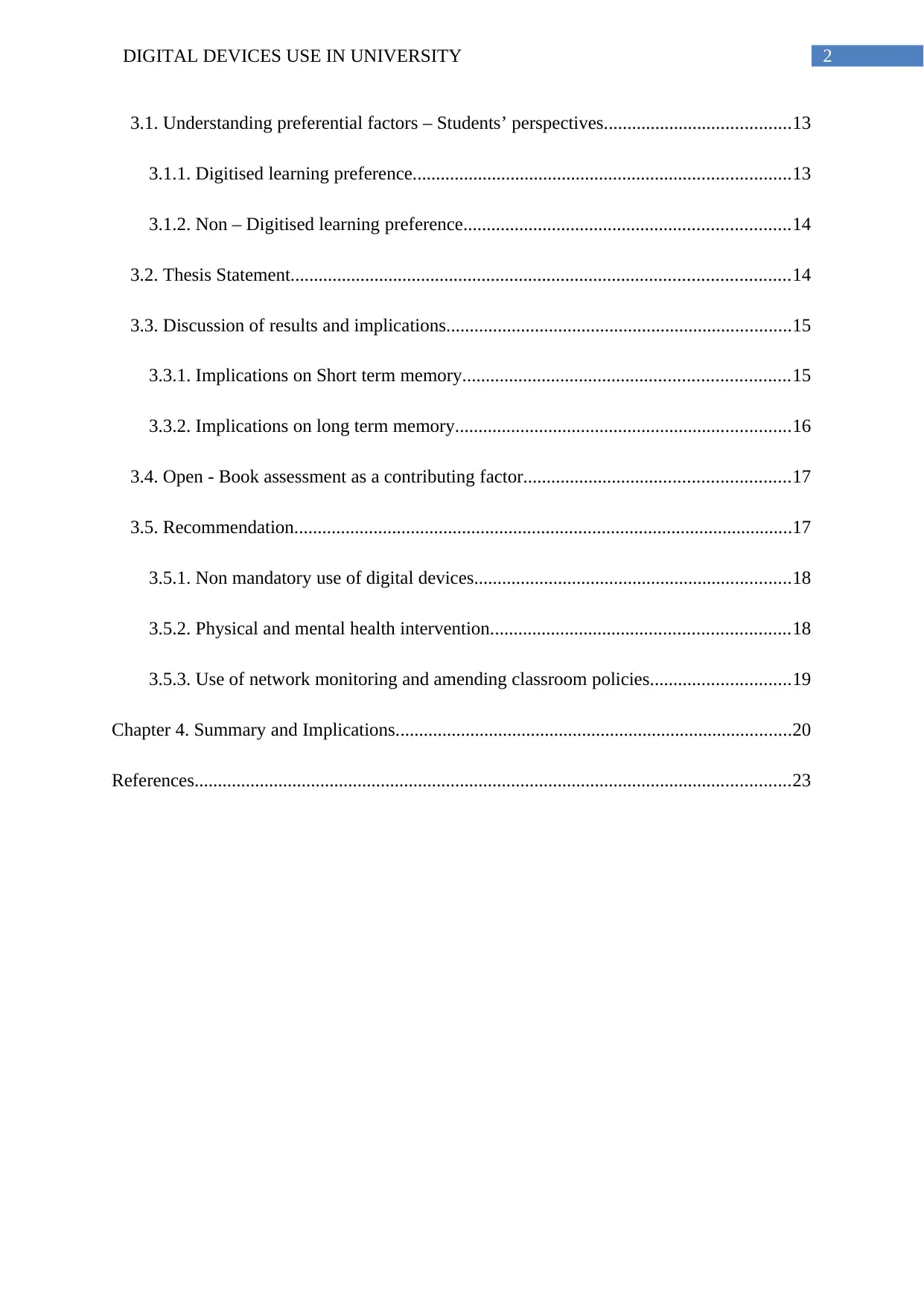
2DIGITAL DEVICES USE IN UNIVERSITY
3.1. Understanding preferential factors – Students’ perspectives........................................13
3.1.1. Digitised learning preference.................................................................................13
3.1.2. Non – Digitised learning preference......................................................................14
3.2. Thesis Statement...........................................................................................................14
3.3. Discussion of results and implications..........................................................................15
3.3.1. Implications on Short term memory......................................................................15
3.3.2. Implications on long term memory........................................................................16
3.4. Open - Book assessment as a contributing factor.........................................................17
3.5. Recommendation...........................................................................................................17
3.5.1. Non mandatory use of digital devices....................................................................18
3.5.2. Physical and mental health intervention................................................................18
3.5.3. Use of network monitoring and amending classroom policies..............................19
Chapter 4. Summary and Implications.....................................................................................20
References................................................................................................................................23
3.1. Understanding preferential factors – Students’ perspectives........................................13
3.1.1. Digitised learning preference.................................................................................13
3.1.2. Non – Digitised learning preference......................................................................14
3.2. Thesis Statement...........................................................................................................14
3.3. Discussion of results and implications..........................................................................15
3.3.1. Implications on Short term memory......................................................................15
3.3.2. Implications on long term memory........................................................................16
3.4. Open - Book assessment as a contributing factor.........................................................17
3.5. Recommendation...........................................................................................................17
3.5.1. Non mandatory use of digital devices....................................................................18
3.5.2. Physical and mental health intervention................................................................18
3.5.3. Use of network monitoring and amending classroom policies..............................19
Chapter 4. Summary and Implications.....................................................................................20
References................................................................................................................................23
⊘ This is a preview!⊘
Do you want full access?
Subscribe today to unlock all pages.

Trusted by 1+ million students worldwide
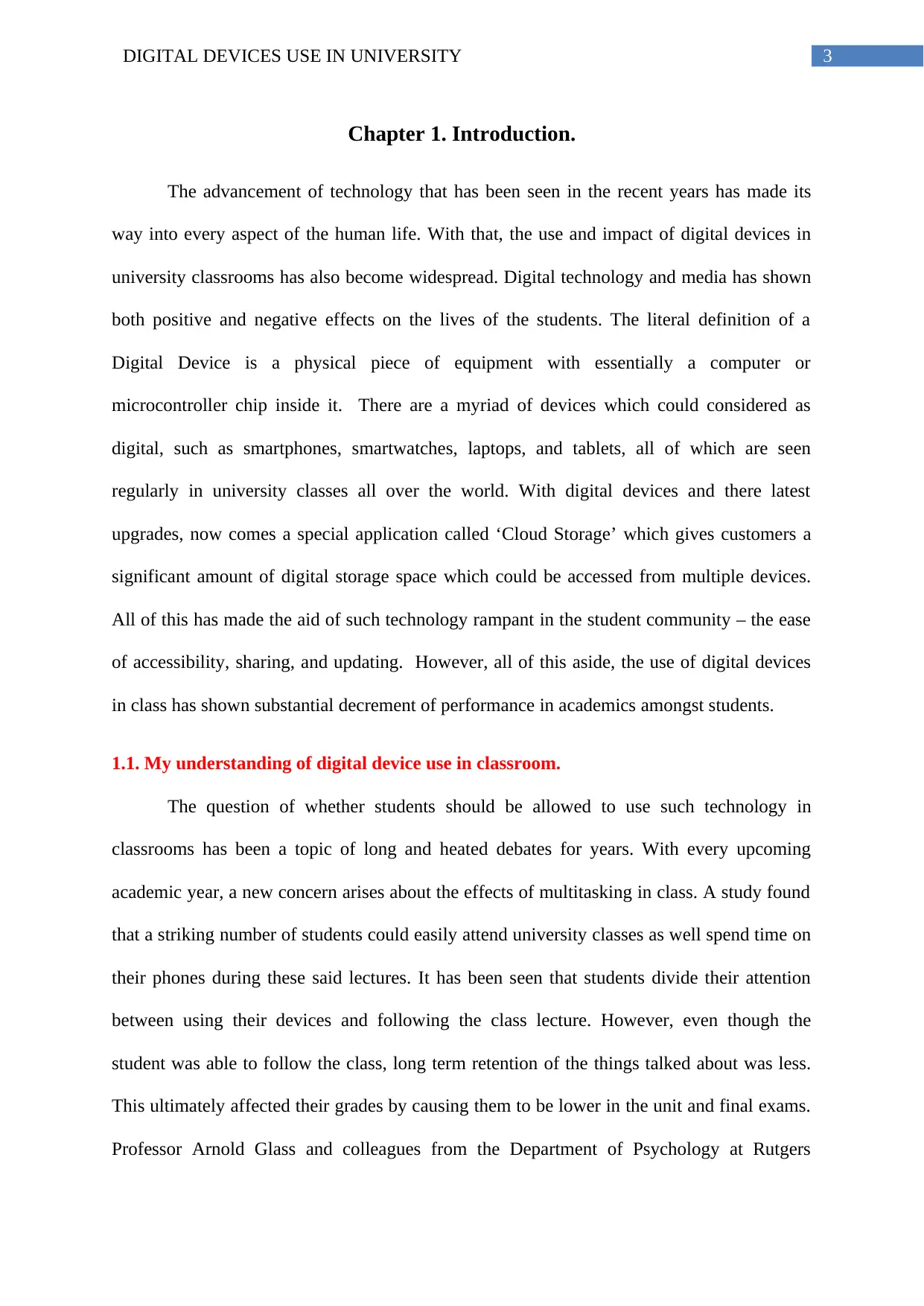
3DIGITAL DEVICES USE IN UNIVERSITY
Chapter 1. Introduction.
The advancement of technology that has been seen in the recent years has made its
way into every aspect of the human life. With that, the use and impact of digital devices in
university classrooms has also become widespread. Digital technology and media has shown
both positive and negative effects on the lives of the students. The literal definition of a
Digital Device is a physical piece of equipment with essentially a computer or
microcontroller chip inside it. There are a myriad of devices which could considered as
digital, such as smartphones, smartwatches, laptops, and tablets, all of which are seen
regularly in university classes all over the world. With digital devices and there latest
upgrades, now comes a special application called ‘Cloud Storage’ which gives customers a
significant amount of digital storage space which could be accessed from multiple devices.
All of this has made the aid of such technology rampant in the student community – the ease
of accessibility, sharing, and updating. However, all of this aside, the use of digital devices
in class has shown substantial decrement of performance in academics amongst students.
1.1. My understanding of digital device use in classroom.
The question of whether students should be allowed to use such technology in
classrooms has been a topic of long and heated debates for years. With every upcoming
academic year, a new concern arises about the effects of multitasking in class. A study found
that a striking number of students could easily attend university classes as well spend time on
their phones during these said lectures. It has been seen that students divide their attention
between using their devices and following the class lecture. However, even though the
student was able to follow the class, long term retention of the things talked about was less.
This ultimately affected their grades by causing them to be lower in the unit and final exams.
Professor Arnold Glass and colleagues from the Department of Psychology at Rutgers
Chapter 1. Introduction.
The advancement of technology that has been seen in the recent years has made its
way into every aspect of the human life. With that, the use and impact of digital devices in
university classrooms has also become widespread. Digital technology and media has shown
both positive and negative effects on the lives of the students. The literal definition of a
Digital Device is a physical piece of equipment with essentially a computer or
microcontroller chip inside it. There are a myriad of devices which could considered as
digital, such as smartphones, smartwatches, laptops, and tablets, all of which are seen
regularly in university classes all over the world. With digital devices and there latest
upgrades, now comes a special application called ‘Cloud Storage’ which gives customers a
significant amount of digital storage space which could be accessed from multiple devices.
All of this has made the aid of such technology rampant in the student community – the ease
of accessibility, sharing, and updating. However, all of this aside, the use of digital devices
in class has shown substantial decrement of performance in academics amongst students.
1.1. My understanding of digital device use in classroom.
The question of whether students should be allowed to use such technology in
classrooms has been a topic of long and heated debates for years. With every upcoming
academic year, a new concern arises about the effects of multitasking in class. A study found
that a striking number of students could easily attend university classes as well spend time on
their phones during these said lectures. It has been seen that students divide their attention
between using their devices and following the class lecture. However, even though the
student was able to follow the class, long term retention of the things talked about was less.
This ultimately affected their grades by causing them to be lower in the unit and final exams.
Professor Arnold Glass and colleagues from the Department of Psychology at Rutgers
Paraphrase This Document
Need a fresh take? Get an instant paraphrase of this document with our AI Paraphraser
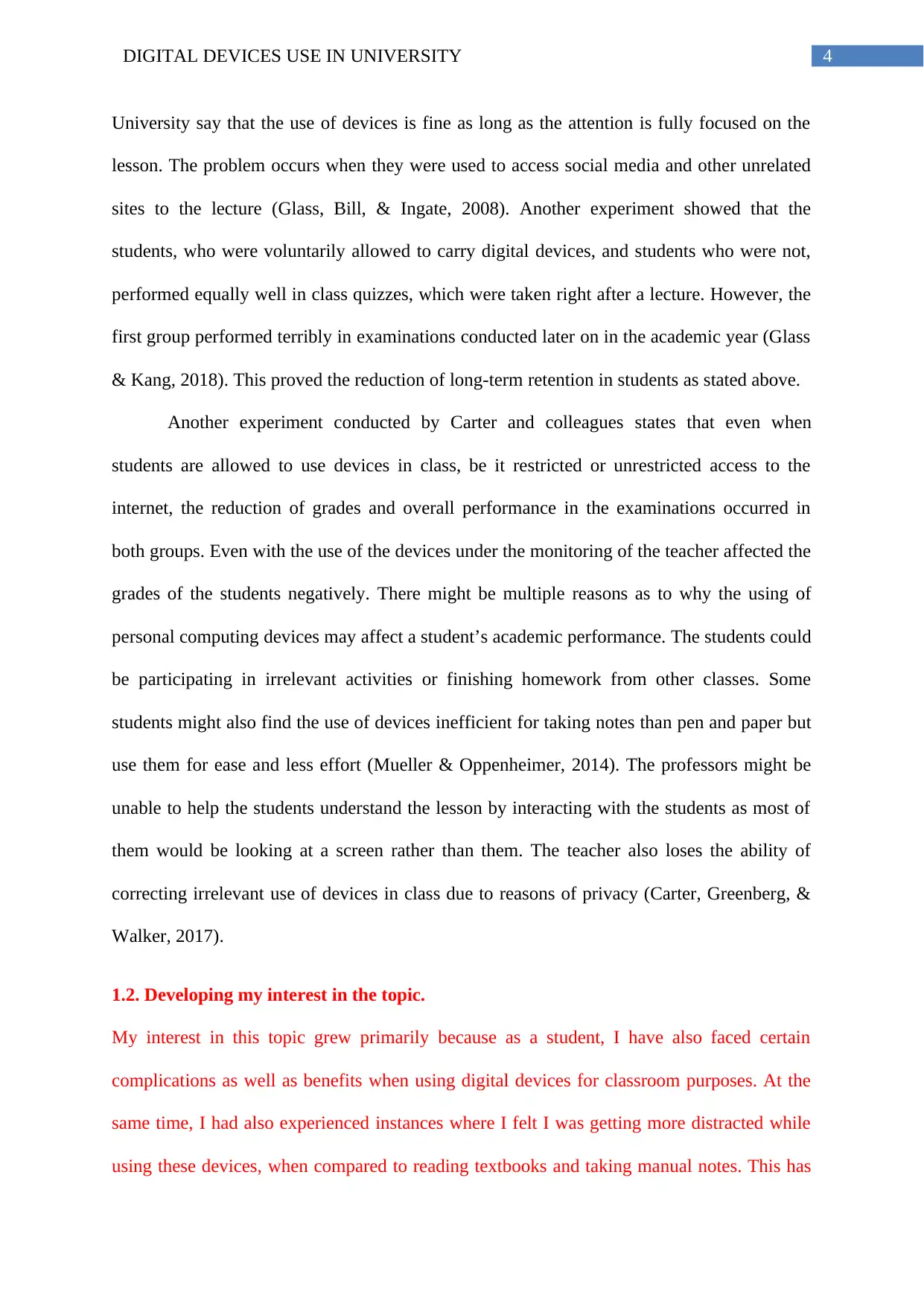
4DIGITAL DEVICES USE IN UNIVERSITY
University say that the use of devices is fine as long as the attention is fully focused on the
lesson. The problem occurs when they were used to access social media and other unrelated
sites to the lecture (Glass, Bill, & Ingate, 2008). Another experiment showed that the
students, who were voluntarily allowed to carry digital devices, and students who were not,
performed equally well in class quizzes, which were taken right after a lecture. However, the
first group performed terribly in examinations conducted later on in the academic year (Glass
& Kang, 2018). This proved the reduction of long-term retention in students as stated above.
Another experiment conducted by Carter and colleagues states that even when
students are allowed to use devices in class, be it restricted or unrestricted access to the
internet, the reduction of grades and overall performance in the examinations occurred in
both groups. Even with the use of the devices under the monitoring of the teacher affected the
grades of the students negatively. There might be multiple reasons as to why the using of
personal computing devices may affect a student’s academic performance. The students could
be participating in irrelevant activities or finishing homework from other classes. Some
students might also find the use of devices inefficient for taking notes than pen and paper but
use them for ease and less effort (Mueller & Oppenheimer, 2014). The professors might be
unable to help the students understand the lesson by interacting with the students as most of
them would be looking at a screen rather than them. The teacher also loses the ability of
correcting irrelevant use of devices in class due to reasons of privacy (Carter, Greenberg, &
Walker, 2017).
1.2. Developing my interest in the topic.
My interest in this topic grew primarily because as a student, I have also faced certain
complications as well as benefits when using digital devices for classroom purposes. At the
same time, I had also experienced instances where I felt I was getting more distracted while
using these devices, when compared to reading textbooks and taking manual notes. This has
University say that the use of devices is fine as long as the attention is fully focused on the
lesson. The problem occurs when they were used to access social media and other unrelated
sites to the lecture (Glass, Bill, & Ingate, 2008). Another experiment showed that the
students, who were voluntarily allowed to carry digital devices, and students who were not,
performed equally well in class quizzes, which were taken right after a lecture. However, the
first group performed terribly in examinations conducted later on in the academic year (Glass
& Kang, 2018). This proved the reduction of long-term retention in students as stated above.
Another experiment conducted by Carter and colleagues states that even when
students are allowed to use devices in class, be it restricted or unrestricted access to the
internet, the reduction of grades and overall performance in the examinations occurred in
both groups. Even with the use of the devices under the monitoring of the teacher affected the
grades of the students negatively. There might be multiple reasons as to why the using of
personal computing devices may affect a student’s academic performance. The students could
be participating in irrelevant activities or finishing homework from other classes. Some
students might also find the use of devices inefficient for taking notes than pen and paper but
use them for ease and less effort (Mueller & Oppenheimer, 2014). The professors might be
unable to help the students understand the lesson by interacting with the students as most of
them would be looking at a screen rather than them. The teacher also loses the ability of
correcting irrelevant use of devices in class due to reasons of privacy (Carter, Greenberg, &
Walker, 2017).
1.2. Developing my interest in the topic.
My interest in this topic grew primarily because as a student, I have also faced certain
complications as well as benefits when using digital devices for classroom purposes. At the
same time, I had also experienced instances where I felt I was getting more distracted while
using these devices, when compared to reading textbooks and taking manual notes. This has
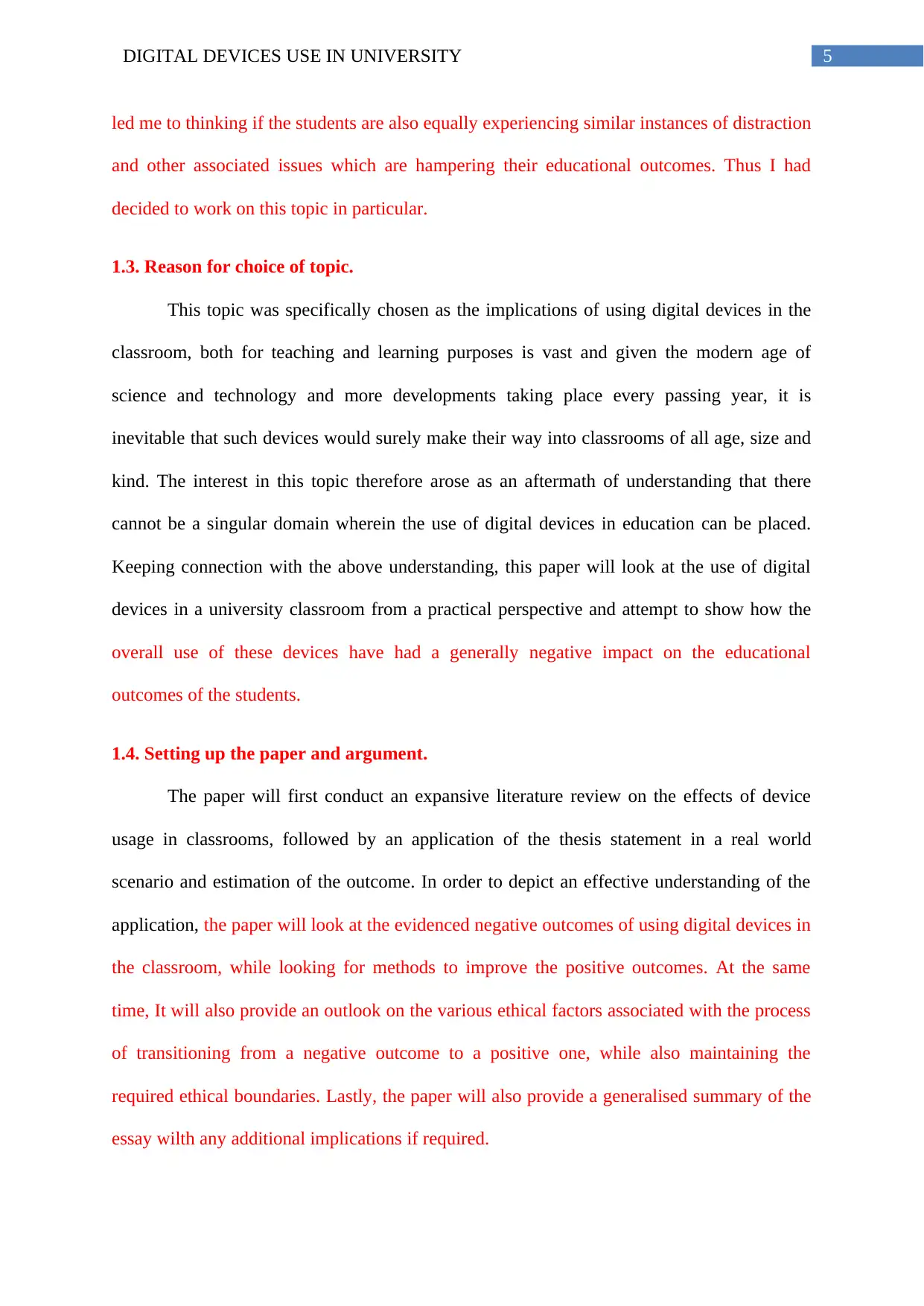
5DIGITAL DEVICES USE IN UNIVERSITY
led me to thinking if the students are also equally experiencing similar instances of distraction
and other associated issues which are hampering their educational outcomes. Thus I had
decided to work on this topic in particular.
1.3. Reason for choice of topic.
This topic was specifically chosen as the implications of using digital devices in the
classroom, both for teaching and learning purposes is vast and given the modern age of
science and technology and more developments taking place every passing year, it is
inevitable that such devices would surely make their way into classrooms of all age, size and
kind. The interest in this topic therefore arose as an aftermath of understanding that there
cannot be a singular domain wherein the use of digital devices in education can be placed.
Keeping connection with the above understanding, this paper will look at the use of digital
devices in a university classroom from a practical perspective and attempt to show how the
overall use of these devices have had a generally negative impact on the educational
outcomes of the students.
1.4. Setting up the paper and argument.
The paper will first conduct an expansive literature review on the effects of device
usage in classrooms, followed by an application of the thesis statement in a real world
scenario and estimation of the outcome. In order to depict an effective understanding of the
application, the paper will look at the evidenced negative outcomes of using digital devices in
the classroom, while looking for methods to improve the positive outcomes. At the same
time, It will also provide an outlook on the various ethical factors associated with the process
of transitioning from a negative outcome to a positive one, while also maintaining the
required ethical boundaries. Lastly, the paper will also provide a generalised summary of the
essay wilth any additional implications if required.
led me to thinking if the students are also equally experiencing similar instances of distraction
and other associated issues which are hampering their educational outcomes. Thus I had
decided to work on this topic in particular.
1.3. Reason for choice of topic.
This topic was specifically chosen as the implications of using digital devices in the
classroom, both for teaching and learning purposes is vast and given the modern age of
science and technology and more developments taking place every passing year, it is
inevitable that such devices would surely make their way into classrooms of all age, size and
kind. The interest in this topic therefore arose as an aftermath of understanding that there
cannot be a singular domain wherein the use of digital devices in education can be placed.
Keeping connection with the above understanding, this paper will look at the use of digital
devices in a university classroom from a practical perspective and attempt to show how the
overall use of these devices have had a generally negative impact on the educational
outcomes of the students.
1.4. Setting up the paper and argument.
The paper will first conduct an expansive literature review on the effects of device
usage in classrooms, followed by an application of the thesis statement in a real world
scenario and estimation of the outcome. In order to depict an effective understanding of the
application, the paper will look at the evidenced negative outcomes of using digital devices in
the classroom, while looking for methods to improve the positive outcomes. At the same
time, It will also provide an outlook on the various ethical factors associated with the process
of transitioning from a negative outcome to a positive one, while also maintaining the
required ethical boundaries. Lastly, the paper will also provide a generalised summary of the
essay wilth any additional implications if required.
⊘ This is a preview!⊘
Do you want full access?
Subscribe today to unlock all pages.

Trusted by 1+ million students worldwide
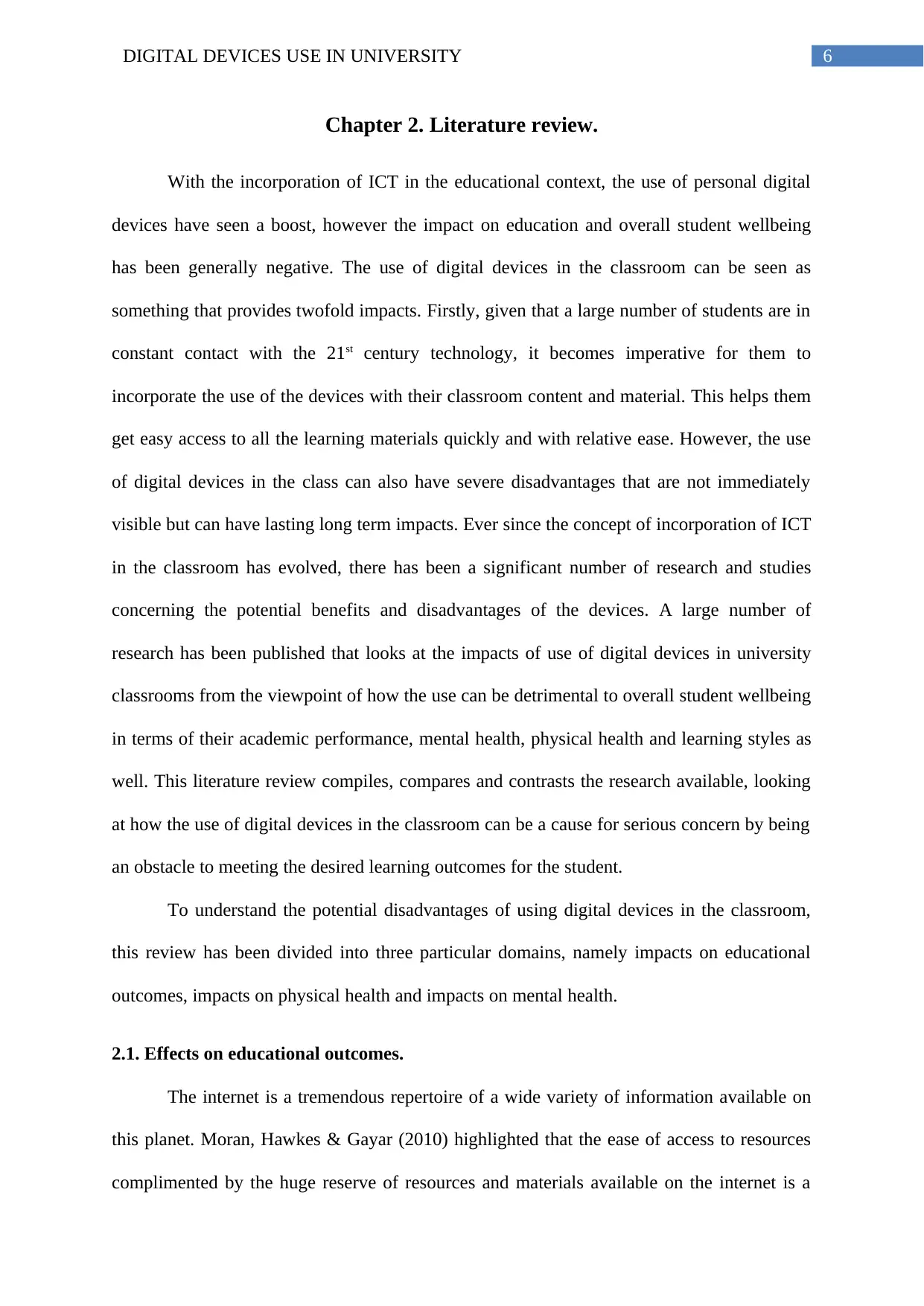
6DIGITAL DEVICES USE IN UNIVERSITY
Chapter 2. Literature review.
With the incorporation of ICT in the educational context, the use of personal digital
devices have seen a boost, however the impact on education and overall student wellbeing
has been generally negative. The use of digital devices in the classroom can be seen as
something that provides twofold impacts. Firstly, given that a large number of students are in
constant contact with the 21st century technology, it becomes imperative for them to
incorporate the use of the devices with their classroom content and material. This helps them
get easy access to all the learning materials quickly and with relative ease. However, the use
of digital devices in the class can also have severe disadvantages that are not immediately
visible but can have lasting long term impacts. Ever since the concept of incorporation of ICT
in the classroom has evolved, there has been a significant number of research and studies
concerning the potential benefits and disadvantages of the devices. A large number of
research has been published that looks at the impacts of use of digital devices in university
classrooms from the viewpoint of how the use can be detrimental to overall student wellbeing
in terms of their academic performance, mental health, physical health and learning styles as
well. This literature review compiles, compares and contrasts the research available, looking
at how the use of digital devices in the classroom can be a cause for serious concern by being
an obstacle to meeting the desired learning outcomes for the student.
To understand the potential disadvantages of using digital devices in the classroom,
this review has been divided into three particular domains, namely impacts on educational
outcomes, impacts on physical health and impacts on mental health.
2.1. Effects on educational outcomes.
The internet is a tremendous repertoire of a wide variety of information available on
this planet. Moran, Hawkes & Gayar (2010) highlighted that the ease of access to resources
complimented by the huge reserve of resources and materials available on the internet is a
Chapter 2. Literature review.
With the incorporation of ICT in the educational context, the use of personal digital
devices have seen a boost, however the impact on education and overall student wellbeing
has been generally negative. The use of digital devices in the classroom can be seen as
something that provides twofold impacts. Firstly, given that a large number of students are in
constant contact with the 21st century technology, it becomes imperative for them to
incorporate the use of the devices with their classroom content and material. This helps them
get easy access to all the learning materials quickly and with relative ease. However, the use
of digital devices in the class can also have severe disadvantages that are not immediately
visible but can have lasting long term impacts. Ever since the concept of incorporation of ICT
in the classroom has evolved, there has been a significant number of research and studies
concerning the potential benefits and disadvantages of the devices. A large number of
research has been published that looks at the impacts of use of digital devices in university
classrooms from the viewpoint of how the use can be detrimental to overall student wellbeing
in terms of their academic performance, mental health, physical health and learning styles as
well. This literature review compiles, compares and contrasts the research available, looking
at how the use of digital devices in the classroom can be a cause for serious concern by being
an obstacle to meeting the desired learning outcomes for the student.
To understand the potential disadvantages of using digital devices in the classroom,
this review has been divided into three particular domains, namely impacts on educational
outcomes, impacts on physical health and impacts on mental health.
2.1. Effects on educational outcomes.
The internet is a tremendous repertoire of a wide variety of information available on
this planet. Moran, Hawkes & Gayar (2010) highlighted that the ease of access to resources
complimented by the huge reserve of resources and materials available on the internet is a
Paraphrase This Document
Need a fresh take? Get an instant paraphrase of this document with our AI Paraphraser
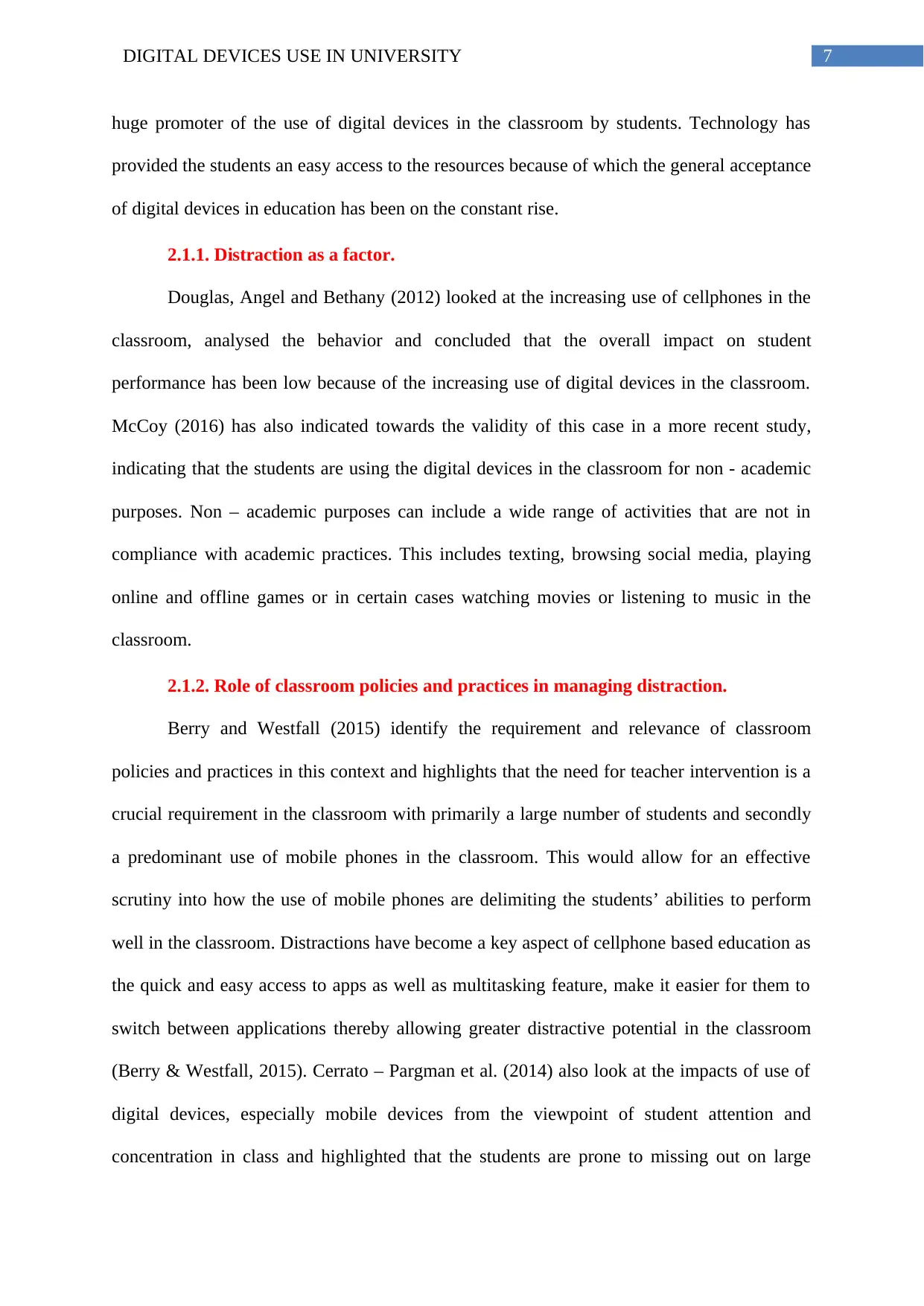
7DIGITAL DEVICES USE IN UNIVERSITY
huge promoter of the use of digital devices in the classroom by students. Technology has
provided the students an easy access to the resources because of which the general acceptance
of digital devices in education has been on the constant rise.
2.1.1. Distraction as a factor.
Douglas, Angel and Bethany (2012) looked at the increasing use of cellphones in the
classroom, analysed the behavior and concluded that the overall impact on student
performance has been low because of the increasing use of digital devices in the classroom.
McCoy (2016) has also indicated towards the validity of this case in a more recent study,
indicating that the students are using the digital devices in the classroom for non - academic
purposes. Non – academic purposes can include a wide range of activities that are not in
compliance with academic practices. This includes texting, browsing social media, playing
online and offline games or in certain cases watching movies or listening to music in the
classroom.
2.1.2. Role of classroom policies and practices in managing distraction.
Berry and Westfall (2015) identify the requirement and relevance of classroom
policies and practices in this context and highlights that the need for teacher intervention is a
crucial requirement in the classroom with primarily a large number of students and secondly
a predominant use of mobile phones in the classroom. This would allow for an effective
scrutiny into how the use of mobile phones are delimiting the students’ abilities to perform
well in the classroom. Distractions have become a key aspect of cellphone based education as
the quick and easy access to apps as well as multitasking feature, make it easier for them to
switch between applications thereby allowing greater distractive potential in the classroom
(Berry & Westfall, 2015). Cerrato – Pargman et al. (2014) also look at the impacts of use of
digital devices, especially mobile devices from the viewpoint of student attention and
concentration in class and highlighted that the students are prone to missing out on large
huge promoter of the use of digital devices in the classroom by students. Technology has
provided the students an easy access to the resources because of which the general acceptance
of digital devices in education has been on the constant rise.
2.1.1. Distraction as a factor.
Douglas, Angel and Bethany (2012) looked at the increasing use of cellphones in the
classroom, analysed the behavior and concluded that the overall impact on student
performance has been low because of the increasing use of digital devices in the classroom.
McCoy (2016) has also indicated towards the validity of this case in a more recent study,
indicating that the students are using the digital devices in the classroom for non - academic
purposes. Non – academic purposes can include a wide range of activities that are not in
compliance with academic practices. This includes texting, browsing social media, playing
online and offline games or in certain cases watching movies or listening to music in the
classroom.
2.1.2. Role of classroom policies and practices in managing distraction.
Berry and Westfall (2015) identify the requirement and relevance of classroom
policies and practices in this context and highlights that the need for teacher intervention is a
crucial requirement in the classroom with primarily a large number of students and secondly
a predominant use of mobile phones in the classroom. This would allow for an effective
scrutiny into how the use of mobile phones are delimiting the students’ abilities to perform
well in the classroom. Distractions have become a key aspect of cellphone based education as
the quick and easy access to apps as well as multitasking feature, make it easier for them to
switch between applications thereby allowing greater distractive potential in the classroom
(Berry & Westfall, 2015). Cerrato – Pargman et al. (2014) also look at the impacts of use of
digital devices, especially mobile devices from the viewpoint of student attention and
concentration in class and highlighted that the students are prone to missing out on large
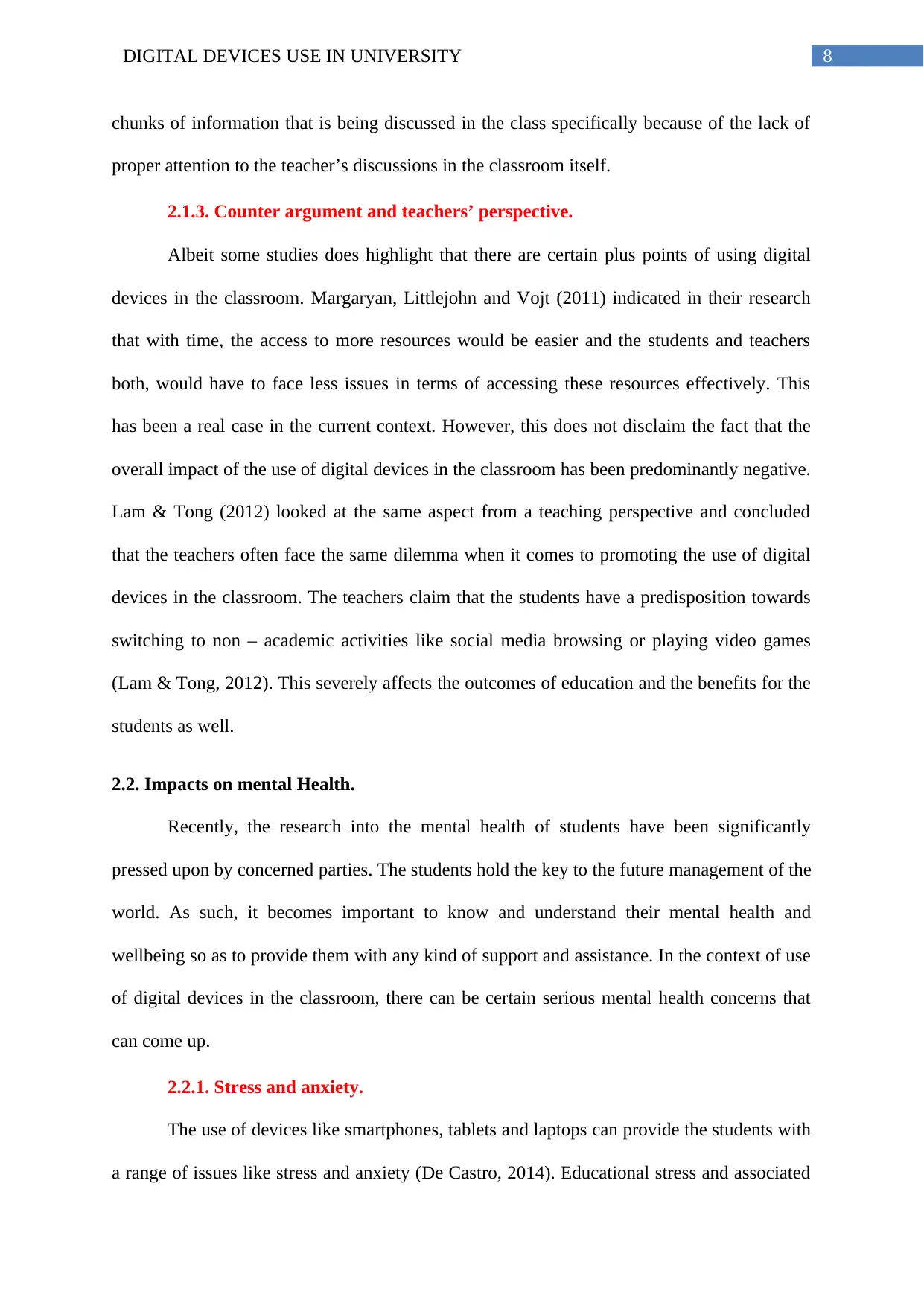
8DIGITAL DEVICES USE IN UNIVERSITY
chunks of information that is being discussed in the class specifically because of the lack of
proper attention to the teacher’s discussions in the classroom itself.
2.1.3. Counter argument and teachers’ perspective.
Albeit some studies does highlight that there are certain plus points of using digital
devices in the classroom. Margaryan, Littlejohn and Vojt (2011) indicated in their research
that with time, the access to more resources would be easier and the students and teachers
both, would have to face less issues in terms of accessing these resources effectively. This
has been a real case in the current context. However, this does not disclaim the fact that the
overall impact of the use of digital devices in the classroom has been predominantly negative.
Lam & Tong (2012) looked at the same aspect from a teaching perspective and concluded
that the teachers often face the same dilemma when it comes to promoting the use of digital
devices in the classroom. The teachers claim that the students have a predisposition towards
switching to non – academic activities like social media browsing or playing video games
(Lam & Tong, 2012). This severely affects the outcomes of education and the benefits for the
students as well.
2.2. Impacts on mental Health.
Recently, the research into the mental health of students have been significantly
pressed upon by concerned parties. The students hold the key to the future management of the
world. As such, it becomes important to know and understand their mental health and
wellbeing so as to provide them with any kind of support and assistance. In the context of use
of digital devices in the classroom, there can be certain serious mental health concerns that
can come up.
2.2.1. Stress and anxiety.
The use of devices like smartphones, tablets and laptops can provide the students with
a range of issues like stress and anxiety (De Castro, 2014). Educational stress and associated
chunks of information that is being discussed in the class specifically because of the lack of
proper attention to the teacher’s discussions in the classroom itself.
2.1.3. Counter argument and teachers’ perspective.
Albeit some studies does highlight that there are certain plus points of using digital
devices in the classroom. Margaryan, Littlejohn and Vojt (2011) indicated in their research
that with time, the access to more resources would be easier and the students and teachers
both, would have to face less issues in terms of accessing these resources effectively. This
has been a real case in the current context. However, this does not disclaim the fact that the
overall impact of the use of digital devices in the classroom has been predominantly negative.
Lam & Tong (2012) looked at the same aspect from a teaching perspective and concluded
that the teachers often face the same dilemma when it comes to promoting the use of digital
devices in the classroom. The teachers claim that the students have a predisposition towards
switching to non – academic activities like social media browsing or playing video games
(Lam & Tong, 2012). This severely affects the outcomes of education and the benefits for the
students as well.
2.2. Impacts on mental Health.
Recently, the research into the mental health of students have been significantly
pressed upon by concerned parties. The students hold the key to the future management of the
world. As such, it becomes important to know and understand their mental health and
wellbeing so as to provide them with any kind of support and assistance. In the context of use
of digital devices in the classroom, there can be certain serious mental health concerns that
can come up.
2.2.1. Stress and anxiety.
The use of devices like smartphones, tablets and laptops can provide the students with
a range of issues like stress and anxiety (De Castro, 2014). Educational stress and associated
⊘ This is a preview!⊘
Do you want full access?
Subscribe today to unlock all pages.

Trusted by 1+ million students worldwide
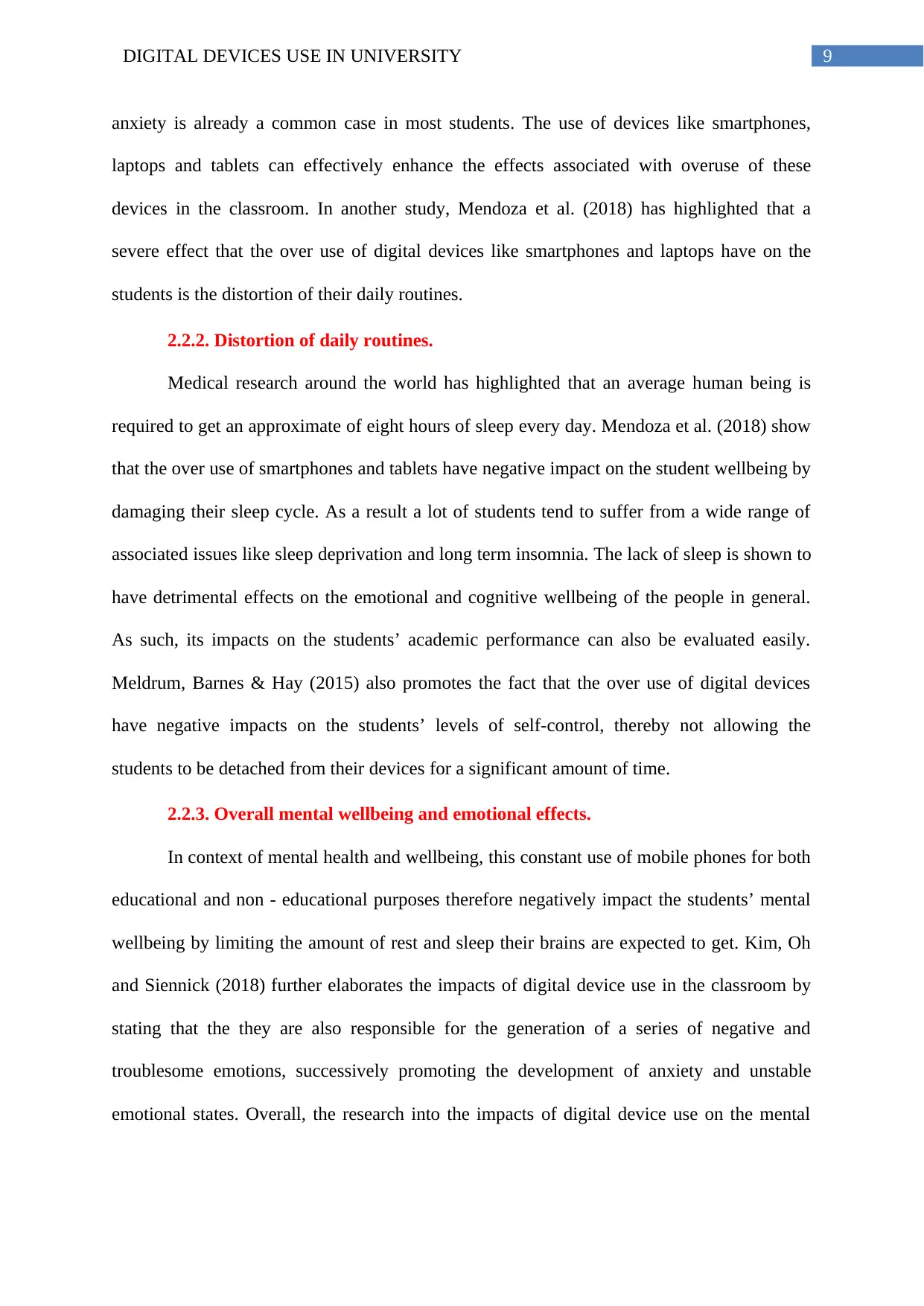
9DIGITAL DEVICES USE IN UNIVERSITY
anxiety is already a common case in most students. The use of devices like smartphones,
laptops and tablets can effectively enhance the effects associated with overuse of these
devices in the classroom. In another study, Mendoza et al. (2018) has highlighted that a
severe effect that the over use of digital devices like smartphones and laptops have on the
students is the distortion of their daily routines.
2.2.2. Distortion of daily routines.
Medical research around the world has highlighted that an average human being is
required to get an approximate of eight hours of sleep every day. Mendoza et al. (2018) show
that the over use of smartphones and tablets have negative impact on the student wellbeing by
damaging their sleep cycle. As a result a lot of students tend to suffer from a wide range of
associated issues like sleep deprivation and long term insomnia. The lack of sleep is shown to
have detrimental effects on the emotional and cognitive wellbeing of the people in general.
As such, its impacts on the students’ academic performance can also be evaluated easily.
Meldrum, Barnes & Hay (2015) also promotes the fact that the over use of digital devices
have negative impacts on the students’ levels of self-control, thereby not allowing the
students to be detached from their devices for a significant amount of time.
2.2.3. Overall mental wellbeing and emotional effects.
In context of mental health and wellbeing, this constant use of mobile phones for both
educational and non - educational purposes therefore negatively impact the students’ mental
wellbeing by limiting the amount of rest and sleep their brains are expected to get. Kim, Oh
and Siennick (2018) further elaborates the impacts of digital device use in the classroom by
stating that the they are also responsible for the generation of a series of negative and
troublesome emotions, successively promoting the development of anxiety and unstable
emotional states. Overall, the research into the impacts of digital device use on the mental
anxiety is already a common case in most students. The use of devices like smartphones,
laptops and tablets can effectively enhance the effects associated with overuse of these
devices in the classroom. In another study, Mendoza et al. (2018) has highlighted that a
severe effect that the over use of digital devices like smartphones and laptops have on the
students is the distortion of their daily routines.
2.2.2. Distortion of daily routines.
Medical research around the world has highlighted that an average human being is
required to get an approximate of eight hours of sleep every day. Mendoza et al. (2018) show
that the over use of smartphones and tablets have negative impact on the student wellbeing by
damaging their sleep cycle. As a result a lot of students tend to suffer from a wide range of
associated issues like sleep deprivation and long term insomnia. The lack of sleep is shown to
have detrimental effects on the emotional and cognitive wellbeing of the people in general.
As such, its impacts on the students’ academic performance can also be evaluated easily.
Meldrum, Barnes & Hay (2015) also promotes the fact that the over use of digital devices
have negative impacts on the students’ levels of self-control, thereby not allowing the
students to be detached from their devices for a significant amount of time.
2.2.3. Overall mental wellbeing and emotional effects.
In context of mental health and wellbeing, this constant use of mobile phones for both
educational and non - educational purposes therefore negatively impact the students’ mental
wellbeing by limiting the amount of rest and sleep their brains are expected to get. Kim, Oh
and Siennick (2018) further elaborates the impacts of digital device use in the classroom by
stating that the they are also responsible for the generation of a series of negative and
troublesome emotions, successively promoting the development of anxiety and unstable
emotional states. Overall, the research into the impacts of digital device use on the mental
Paraphrase This Document
Need a fresh take? Get an instant paraphrase of this document with our AI Paraphraser
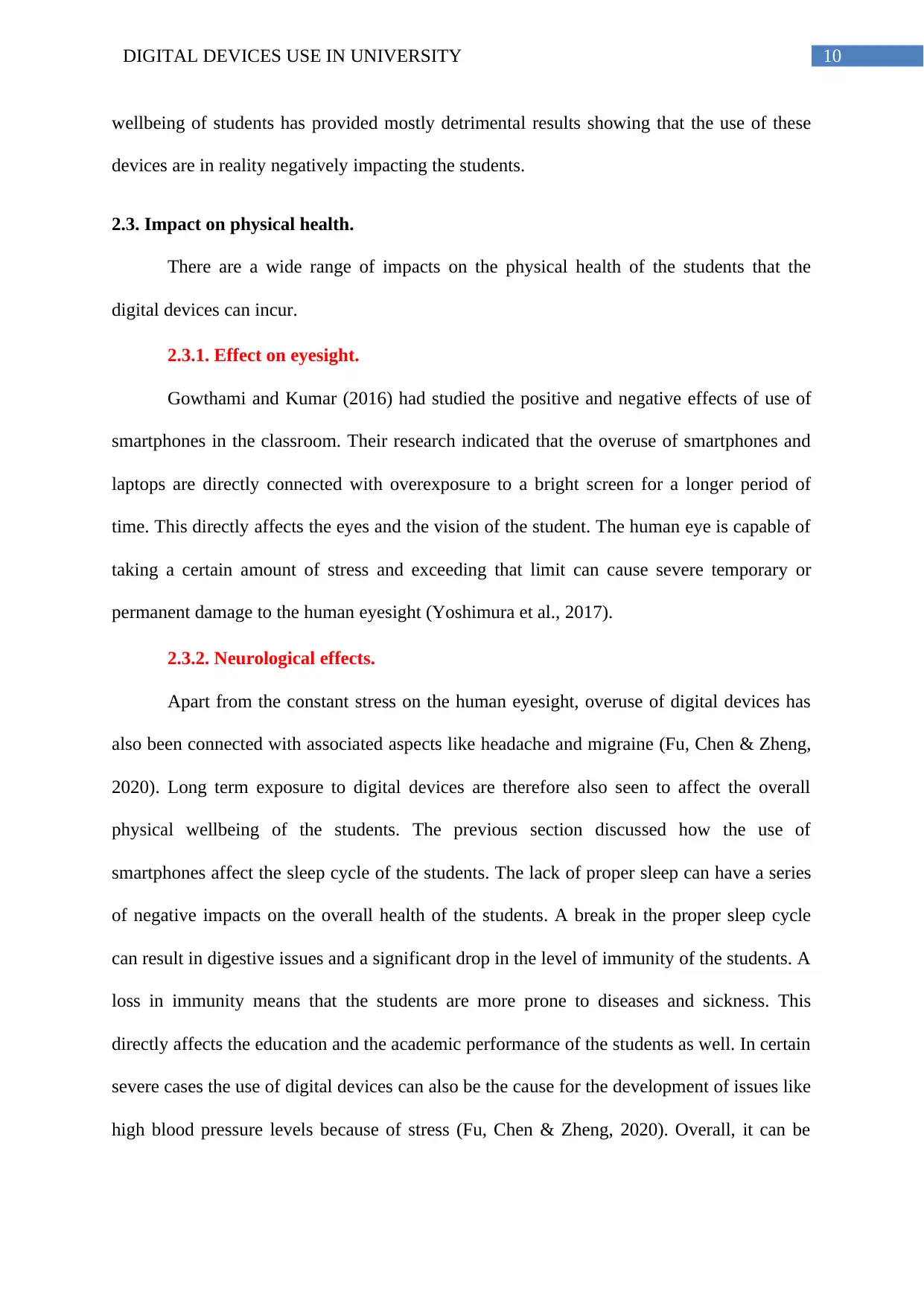
10DIGITAL DEVICES USE IN UNIVERSITY
wellbeing of students has provided mostly detrimental results showing that the use of these
devices are in reality negatively impacting the students.
2.3. Impact on physical health.
There are a wide range of impacts on the physical health of the students that the
digital devices can incur.
2.3.1. Effect on eyesight.
Gowthami and Kumar (2016) had studied the positive and negative effects of use of
smartphones in the classroom. Their research indicated that the overuse of smartphones and
laptops are directly connected with overexposure to a bright screen for a longer period of
time. This directly affects the eyes and the vision of the student. The human eye is capable of
taking a certain amount of stress and exceeding that limit can cause severe temporary or
permanent damage to the human eyesight (Yoshimura et al., 2017).
2.3.2. Neurological effects.
Apart from the constant stress on the human eyesight, overuse of digital devices has
also been connected with associated aspects like headache and migraine (Fu, Chen & Zheng,
2020). Long term exposure to digital devices are therefore also seen to affect the overall
physical wellbeing of the students. The previous section discussed how the use of
smartphones affect the sleep cycle of the students. The lack of proper sleep can have a series
of negative impacts on the overall health of the students. A break in the proper sleep cycle
can result in digestive issues and a significant drop in the level of immunity of the students. A
loss in immunity means that the students are more prone to diseases and sickness. This
directly affects the education and the academic performance of the students as well. In certain
severe cases the use of digital devices can also be the cause for the development of issues like
high blood pressure levels because of stress (Fu, Chen & Zheng, 2020). Overall, it can be
wellbeing of students has provided mostly detrimental results showing that the use of these
devices are in reality negatively impacting the students.
2.3. Impact on physical health.
There are a wide range of impacts on the physical health of the students that the
digital devices can incur.
2.3.1. Effect on eyesight.
Gowthami and Kumar (2016) had studied the positive and negative effects of use of
smartphones in the classroom. Their research indicated that the overuse of smartphones and
laptops are directly connected with overexposure to a bright screen for a longer period of
time. This directly affects the eyes and the vision of the student. The human eye is capable of
taking a certain amount of stress and exceeding that limit can cause severe temporary or
permanent damage to the human eyesight (Yoshimura et al., 2017).
2.3.2. Neurological effects.
Apart from the constant stress on the human eyesight, overuse of digital devices has
also been connected with associated aspects like headache and migraine (Fu, Chen & Zheng,
2020). Long term exposure to digital devices are therefore also seen to affect the overall
physical wellbeing of the students. The previous section discussed how the use of
smartphones affect the sleep cycle of the students. The lack of proper sleep can have a series
of negative impacts on the overall health of the students. A break in the proper sleep cycle
can result in digestive issues and a significant drop in the level of immunity of the students. A
loss in immunity means that the students are more prone to diseases and sickness. This
directly affects the education and the academic performance of the students as well. In certain
severe cases the use of digital devices can also be the cause for the development of issues like
high blood pressure levels because of stress (Fu, Chen & Zheng, 2020). Overall, it can be
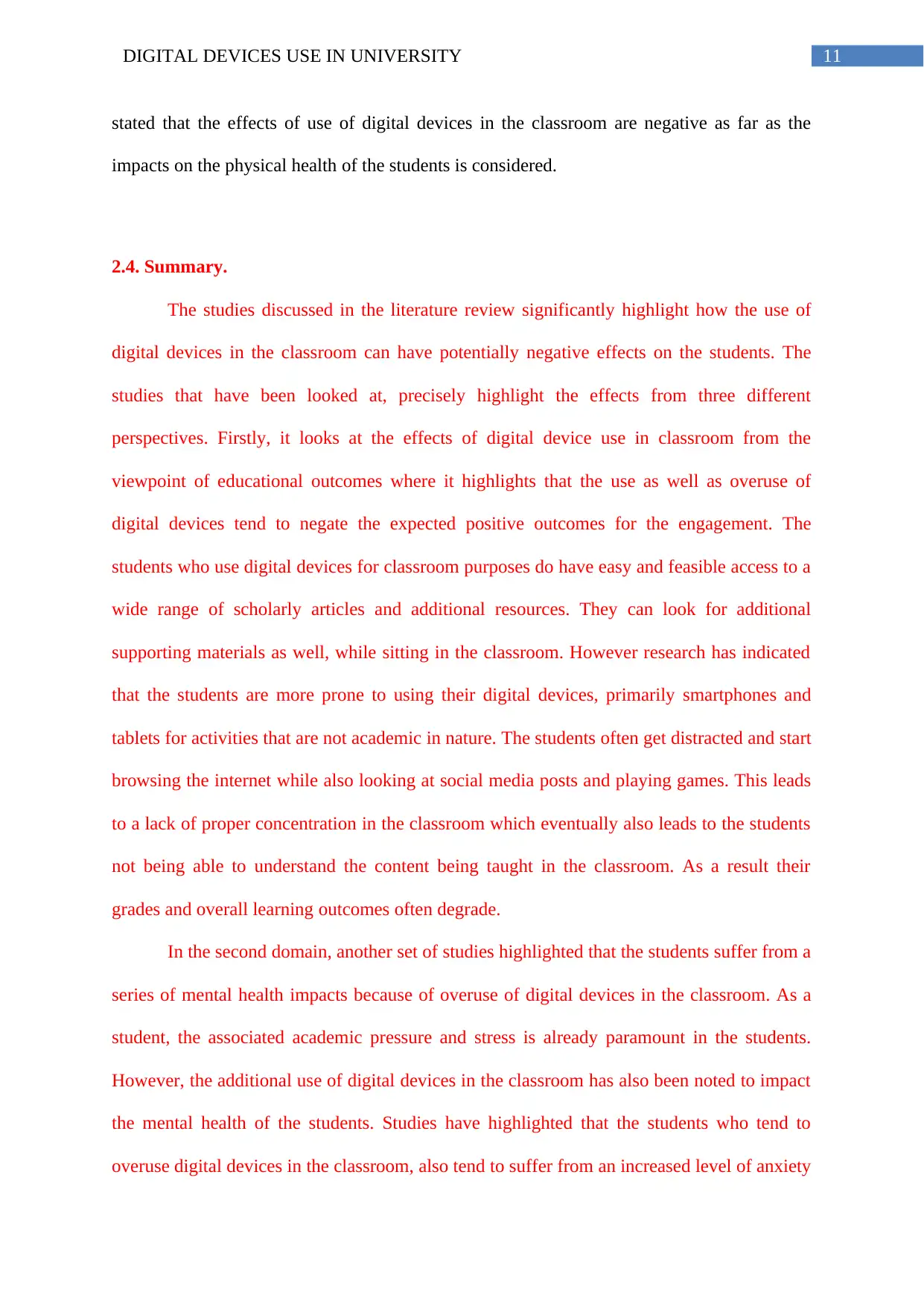
11DIGITAL DEVICES USE IN UNIVERSITY
stated that the effects of use of digital devices in the classroom are negative as far as the
impacts on the physical health of the students is considered.
2.4. Summary.
The studies discussed in the literature review significantly highlight how the use of
digital devices in the classroom can have potentially negative effects on the students. The
studies that have been looked at, precisely highlight the effects from three different
perspectives. Firstly, it looks at the effects of digital device use in classroom from the
viewpoint of educational outcomes where it highlights that the use as well as overuse of
digital devices tend to negate the expected positive outcomes for the engagement. The
students who use digital devices for classroom purposes do have easy and feasible access to a
wide range of scholarly articles and additional resources. They can look for additional
supporting materials as well, while sitting in the classroom. However research has indicated
that the students are more prone to using their digital devices, primarily smartphones and
tablets for activities that are not academic in nature. The students often get distracted and start
browsing the internet while also looking at social media posts and playing games. This leads
to a lack of proper concentration in the classroom which eventually also leads to the students
not being able to understand the content being taught in the classroom. As a result their
grades and overall learning outcomes often degrade.
In the second domain, another set of studies highlighted that the students suffer from a
series of mental health impacts because of overuse of digital devices in the classroom. As a
student, the associated academic pressure and stress is already paramount in the students.
However, the additional use of digital devices in the classroom has also been noted to impact
the mental health of the students. Studies have highlighted that the students who tend to
overuse digital devices in the classroom, also tend to suffer from an increased level of anxiety
stated that the effects of use of digital devices in the classroom are negative as far as the
impacts on the physical health of the students is considered.
2.4. Summary.
The studies discussed in the literature review significantly highlight how the use of
digital devices in the classroom can have potentially negative effects on the students. The
studies that have been looked at, precisely highlight the effects from three different
perspectives. Firstly, it looks at the effects of digital device use in classroom from the
viewpoint of educational outcomes where it highlights that the use as well as overuse of
digital devices tend to negate the expected positive outcomes for the engagement. The
students who use digital devices for classroom purposes do have easy and feasible access to a
wide range of scholarly articles and additional resources. They can look for additional
supporting materials as well, while sitting in the classroom. However research has indicated
that the students are more prone to using their digital devices, primarily smartphones and
tablets for activities that are not academic in nature. The students often get distracted and start
browsing the internet while also looking at social media posts and playing games. This leads
to a lack of proper concentration in the classroom which eventually also leads to the students
not being able to understand the content being taught in the classroom. As a result their
grades and overall learning outcomes often degrade.
In the second domain, another set of studies highlighted that the students suffer from a
series of mental health impacts because of overuse of digital devices in the classroom. As a
student, the associated academic pressure and stress is already paramount in the students.
However, the additional use of digital devices in the classroom has also been noted to impact
the mental health of the students. Studies have highlighted that the students who tend to
overuse digital devices in the classroom, also tend to suffer from an increased level of anxiety
⊘ This is a preview!⊘
Do you want full access?
Subscribe today to unlock all pages.

Trusted by 1+ million students worldwide
1 out of 27
Related Documents
Your All-in-One AI-Powered Toolkit for Academic Success.
+13062052269
info@desklib.com
Available 24*7 on WhatsApp / Email
![[object Object]](/_next/static/media/star-bottom.7253800d.svg)
Unlock your academic potential
Copyright © 2020–2025 A2Z Services. All Rights Reserved. Developed and managed by ZUCOL.





